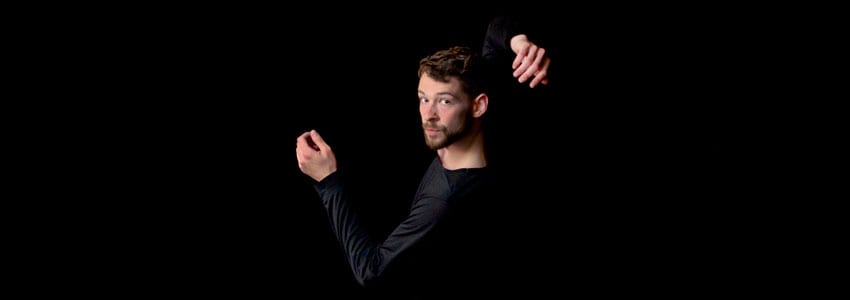Michael performed in a dance company in Kalamazoo for two seasons after completing his undergraduate degree at Hope College, but it wasn’t fueling him in the ways he needed. He explains, “I felt I wasn’t satisfying my artistic desire and hunger.” Coming to U-M fixed that. “When I came here, the first semester was largely about asking questions of my own work, and I always felt performing was really important to how I understand myself in the world. Acts of performance have something to do with the kind of person I am.”
Specifically, Michael researches how the identity of a body is shaped by and through acts of performance. “In particular, I started by looking at drag performance and noted how a drag king or queen makes up his or her character. I noticed their on stage identity is often fairly close to their off stage identity. I use the act of performance to create something; performance is a space for enacting needs and desires.” he describes.
His Master’s thesis involves an ensemble of dancers with whom he’s worked all year, reading, writing, and making performances with the goal of collecting a really rich history of movement to make into an improvisational performance. He continues, “We’ll use this history plus improvisation to make something new. I’m really curious about the creation of space, the distances between past, present and future, improvisation, and what can be made with all of this in mind. I think of that as Ensemble Desire. At once we are fragile, strong, and dynamic; and this is the stuff of life.”
He continues, “Dance as a discipline of artistry and research is collaborative in nature. In working with the ensemble, a key challenge has been teaching myself how to embody these research questions and then to get others on board with my ideas by teaching them my frame of reference.” After the thesis performance, Michael will dig into the research, spending the first half summer writing his thesis document and building a website portfolio that archives this work specifically.
He considers this reflection on the performance to represent how he’ll look at performance going forward with his career. He explains, “With this work specifically, so much of the labor is processing the performance after it’s completed. I imagine pulling it apart to see what I can do with the bits and pieces of the work, to find what is yet ripe for exploration. I want to know how this project and process will influence how I teach in the future, and how will it inform what I do with the next collective of dancers. From this project I’d also like to glean a solo work that is an essential cropped version of the performance. That might be the next phase of the project and result in something I can submit to festivals for performance or as part of an application portfolio for a dance residency elsewhere. I’m starting to really feel the accomplishment of the last two years of work because know I can take so much of this with me to wherever I go next. That’s the point of the work. My faculty has encouraged me to situate my current project around my past work – how do my experiences as a dancer feed into this? I think about how this work will take me forward.” He hopes to then transition to New York to focus on performance upon graduation.
A self-described ‘really, really social person’, Michael seems constantly on the move. His fun centers around dance, whether teaching or cutting loose in a club, and he occasionally spends time on the tennis or racquetball courts. “I’m really fortunate to be doing what I’m doing. My work isn’t so separate from my social life. That’s sort of how the dance industry works. That can be tricky, though. You have to figure out how to relate both socially and professionally to the same person. Grad school has definitely helped me develop some good skills and strategies for managing this.”
He says, “Being situated in Rackham has been really fantastic. I’ve had the opportunity to take amazing courses and interact with brilliant people that I didn’t know would be an option for me. I pursued a Certificate in World Performance Studies that was very multidisciplinary in makeup. It was great to sit in a room with other grad students and put my questions on the table and hash them out with other people with different perspectives.”
The Master’s dance program is much smaller: his cohort has only four students. That’s worked out well for Michael, as he comments, “It’s wonderful to have small group of people to work really closely with for two years. I value having peers who know my work and who are interested in knowing my work. That pushes it along in new ways.”
Michael came to U-M without much teaching experience, but found teaching to be one of the best experiences he’s had at U-M. He describes, “I’ve GSI’d for five different classes, and that has been really wonderful. I’ve learned a lot about movement by observing other bodies doing the movement that I teach them. It’s like some kind of an informational mirror. It’s been really valuable having that job to learn from in my time here. I focus specifically on performance; it gives me so much information. I still want to collect, know and understand. Performance informs how I teach, how I make work. I see this as a stepping stone into finding my voice as a master maker or master instructor.”

